|
 Armillaria novae-zelandiae Armillaria novae-zelandiae
SynonymsArmillariella novae-zelandiae
Agaricus melleus
Armillaria mellea
Armillariella mellea
Armillaria novae-zelandiae
BiostatusPresent in region - Indigenous. Non endemic
Images (click to enlarge)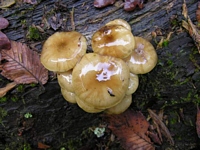
Owner: B. Dee | 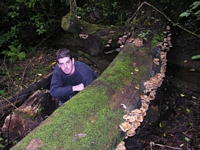
Owner: B. Dee | 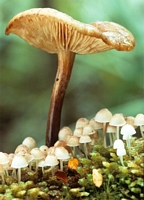
Owner: Herb. PDD | 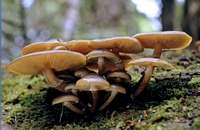
Caption: 97/98
Owner: Peter Buchanan | 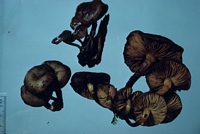
Owner: Herb. PDD | 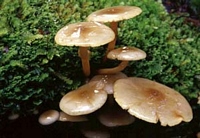
Caption: Armillaria novae-zealandiae
Owner: Kaimai Bush | 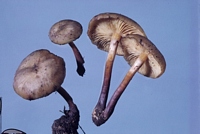
Owner: Herb. PDD | 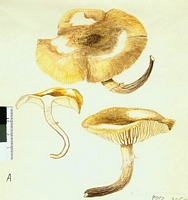
Caption: Watercolour
Owner: G.M. Taylor | 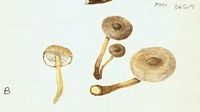
Caption: Watercolour
Owner: G.M. Taylor | 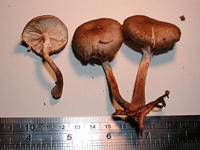
Caption: fruitbody
Owner: J.A. Cooper | 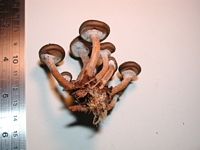
Caption: fruitbody
Owner: J.A. Cooper | 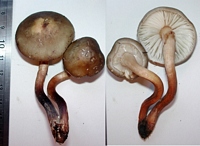
Caption: fruitbody
Owner: J.A. Cooper | 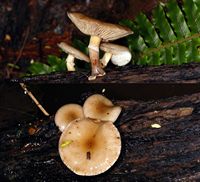
Owner: J.A. Cooper | 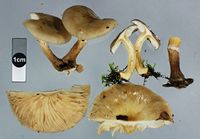
Owner: J.A. Cooper | 
Caption: Fig. 25 | 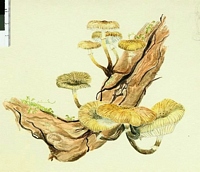
Caption: Watercolour
Owner: G.M. Taylor | 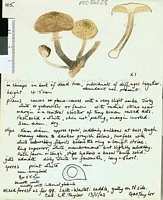
Caption: Watercolour
Owner: G.M. Taylor | 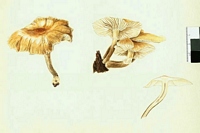
Caption: Watercolour
Owner: G.M. Taylor |
Notes: A. novae-zelandiae is smaller than A. limonea and has a smoother, dull brown cap.
Article: Stevenson, G. (1964). The Agaricales of New Zealand: V. Kew Bulletin 19(1): 1-59.
Description: Pileus 3-8 cm diam., olive-buff to olive-brown, sprinkled at centre with very small dull brown scales, convex at first with a strongly down-rolled margin, becoming plane to shallow concave, moist when fresh with a conspicuously striate margin, drying matt; flesh creamy white. Gills decurrent to a most sinuate, creamy white becoming dull fawn, moderately crowded with many short members. Stipe 4-7 x 0.4-0.8 cm, fawn above evanescent ring, brown to dark purplish brown below, smooth or striate, tough, solid, bases swollen and united. Spores 8-9 x 5.5-6.5µm, non-amyloid rather thick-walled (Fig. 24). Spore print white.
Habitat: In dense groups round standing dead broad-leaved trees, or on their fallen timber, Wellington Botanic Garden, 2.6.1949, Stevenson, Eastbourne, Wellington, 4.6.1949, Stevenson (type); Butterfly, 2.6.1958, Stevenson; Otari, 22.6.1958, Stevenson, Kapiti, 22.6.1958, M. Davidson.
Article: Horak, E. (1971). A contribution towards the revision of the Agaricales (Fungi) from New Zealand. New Zealand Journal of Botany 9(3): 403-462 (http://www.rsnz.org/publish/abstracts.php).
Notes: According to Singer (1969) this species was also collected in the Nothofagus
forests of South America.
Article: Gadgil, P.D. (in association with Dick, M.A.; Hood, I.A.; Pennycook, S.R.) (2005). Fungi on trees and shrubs in New Zealand. Fungi of New Zealand. Ngā Harore o Aotearoa 4: xi + 437 p. Hong Kong: Fungal Diversity Press.
Description: Type: Radicicolous Fungi; Description: Basidiomata pileate, centrally stipitate. Pileus 30–80 mm in diameter, olive buff to olive brown, sprinkled with very small dull brown scales at the centre, convex at first, becoming plane to shallow concave; flesh creamy white. Gills decurrent to almost sinuate, moderately crowded, creamy white becoming dull fawn. Stipe tapering towards the base, fawn above evanescent annulus, brown to dark purplish below, smooth or striate, solid, 40–70 mm long. Basidiospores ellipsoid to elongate-ellipsoid, 7–9 × 5–6 m, non-amyloid; spore print white.
Distribution: Distribution: See Significance.; 1st Record: Stevenson (1964: as Armillariella novaezelandiae).
Article: Cooke, M.C. (1879). New Zealand fungi. Grevillea 8(46): 54-68.
Habitat: On trunks. Maungaroa (144).
Article: Massee, G.E. (1899) [1898]. The fungus flora of New Zealand. Transactions and Proceedings of the New Zealand Institute 31: 282–349 Wellington:.
Description: Pileus 5-12 cm. across, disc fleshy, remainder thin, convex then expanded, often becoming
more or less depressed at the centre, often sooty or covered with olive down when young,
soon paler; usually ochraceous with a tinge of honey-colour, sprinkled all over with small
spreading blackish-brown scales, margin striate; gills adnate, then becoming more or less
decurrent, rather distant, white with a pink tinge, then brownish and powdered with the white
.spores; stem 6-12 cm. long, 1-1.5 cm. thick, rigid, more or less grooved, dingy-ochraceous,
floccose or almost naked below the ring, base often covered with yellowish down, stuffed,
then hollow, elastic, ring near the apex; spores elliptical, 9 x 5-6 µ.
Habitat: At the base of trunks or on the ground, springing from buried wood.
Distribution: Maungaroa, New
Zealand. Europe, North America, South America, Australia, India.
Notes: Usually densely tufted, although sometimes solitary, and then usually larger; very variable;
stem and pileus often quite glabrous, especially when old. A very destructive parasite to
timber trees in Europe, the black cord-like strands of mycelium running between the wood
and the bark, also travelling in the ground from one tree to another. These strands of
mycelium were at one time considered as constituting a distinct genus of Fungi called
Rhizomorpha.
Article: Stevenson, G. (1964). The Agaricales of New Zealand: V. Kew Bulletin 19(1): 1-59.
Description: This common tree-destroying fungus with very characteristic bootlace rhizomorphs is regularly seen in plantations. In Japan it is recognized as the mycorrhizal fungus of the saprophytic orchid Gastrodia R. Br., one species of which is fairly common throughout New Zealand.
|